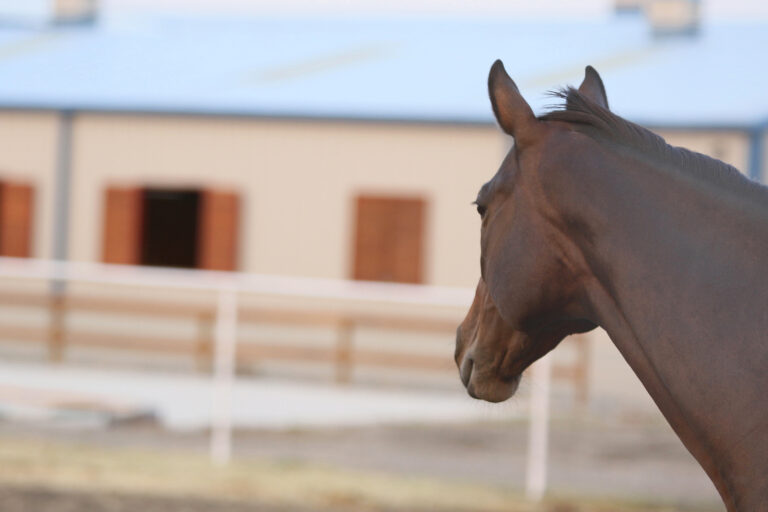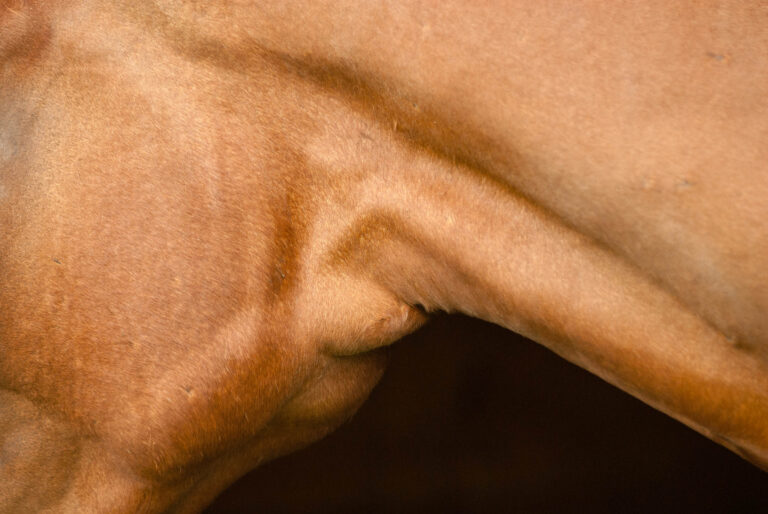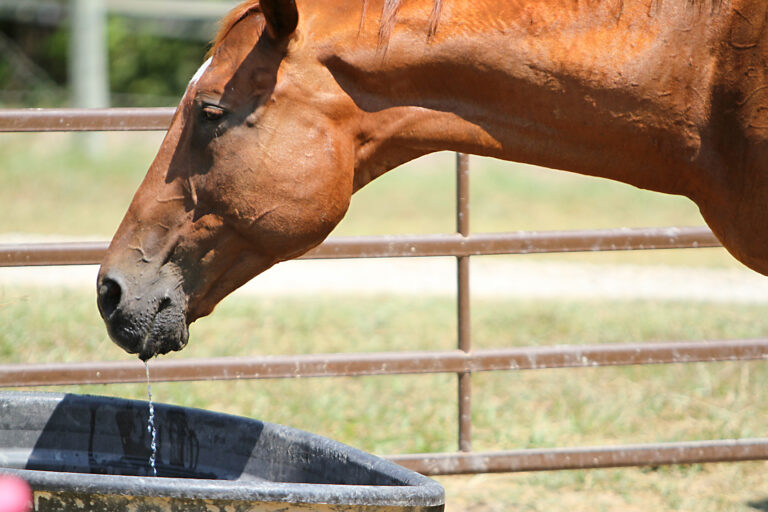Like most other animals, horses don’t make particular sounds that convey a single idea, but they certainly use vocal noises to get across general ideas or emotions. I’ll start with the lower-keyed sounds you’re likely to hear from your horse and move up to the more intense, explaining the clues that help refine what he’s “telling” you (or his buddies) with each sound-off.
Sighing
Horses seem to sigh, draw in a deep breath, then let it out slowly and audibly through mouth or nostrils, much more around humans than when interacting with each other. There’s a sigh that seems to express relief (like your “Aaaaah!” when removing a pair of tight boots), which you may hear as grooming or massage releases tension in your horse’s muscles. There’s a relaxation sigh that you watch and listen for when longeing to loosen him up and make sure he’s calm before you get on: the one where he puts his head forward and down and exhales a deep fluttering breath through his nostrils, often more than once, “Yeah, I feel better now.” Some horses also give a sigh suggestive of boredom when ring work is too repetitive; the equine equivalent of the “ho-hum” you might breathe if stuck in line at the supermarket, it’s a hint to try a different gymnastic, find some new patterns to ride on the flat, or go for a trail ride.
Groaning
As in humans, groaning can be a habit in horses but can also signal pain, so it calls for some detective work, especially if the horse is new to you and you don’t know which noises and in which situations are normal for him.
If he groans or grunts over fences but otherwise seems happy, he’s probably like the tennis player who habitually gives an “oof!” with every serve. But if he groans on landing from his fences and also pins his ears or rolls his eyes, something’s hurting. It could be his back (does he resist saddling and/or girthing, tuck his hindquarters or tail when you mount, hollow his back as you settle into the saddle?), legs or feet (check them daily for heat, and watch for a resting stance that takes some weight off his front feet, a sign of laminitis), or his insides (adhesions from past abdominal surgery are a possibility; if you don’t know his history, check for incision scars on belly or flank).
If he groans only with certain riders, a rider who thuds heavily into the saddle after a jump or at sitting trot might be hurting him. If he habitually groans when manuring but otherwise seems normal and happy, the groan could simply be the involuntary movement of air through his vocal cords as he uses his diaphragm to bear down in defecation, or a response to normal abdominal discomfort/relief. But if he suddenly begins to groan while manuring, and especially if he appears to strain and the manure is dry and firm, suspect the early stages of impaction. Monitor his water consumption; listen with an ear to his flank on both sides for normal gut sounds; take his pulse and heart rate. Check his hydration with a pinch test (a pinched-and-released fold of neck skin should regain its original contour in less than two seconds), and check his gums. If they’re dark pink and/or tacky to the touch, or if any of the other signs above are not normal, call your veterinarian.
Groaning when not under saddle could also be a sign of gastric pain from ulcers: Recent studies suggest that at least sixty percent of performance horses have ulcers; if your horse groans and shows other ulcer symptoms your veterinarian may suggest an endoscopic examination.
See also: Understanding Ulcers
Some horses groan when they know work is over; in the absence of the trouble symptoms above, they’re probably just anticipating getting the saddle off, having a roll, manuring, and eating some hay.
See also: 6 Steps to Protect Gut Health
Nickering
Your horse uses his vocal cords but keeps his lips closed for this soft sound. It’s usually (though not always) one of friendly recognition and welcome “Hi! Good, you’re here! Come talk with me!” coupled with an alert expression, raised head, ears pricked in your direction. (The lovely nicker of a mare to her foal is the same kind of affectionate summons.)
If your appearance at particular times usually means food on the way, the nickering may have an edge of happy anticipation. If others get fed first, your horse’s nicker probably becomes more rapid and high-pitched: “Come on, now!” But horses also nicker in a more subdued way, from apprehension, “Uh-oh, this looks bad; what should I do?” if they feel cornered and threatened. This nicker combined with fearful body language–pacing, ears flicking back and forth, eyes rolling–is a signal to remove your horse from the threatening situation or reassure him with gentle grooming or massage and quiet talking.
Blowing or Snorting
When your horse inhales quickly, then puffs the breath out through his nostrils so they vibrate with a loud purring sound, he’s excited and hoping that something will happen. Maybe he sees you getting his lead rope at turnout time: “Oh good, we’re going out, we’re going out!” Horses actually get themselves (and others) even more worked up just by making this sound; so if yours continues blowing, head raised and tail lifted, as you lead him out, be prepared for sudden moves. Remind him you’re still in charge with quiet halts, or by leading him in a small circle before you open the gate. Otherwise he might try to explode away from you, especially if friends are waiting to play. On the trail, he may begin blowing if you come to a stretch where you normally canter, or if a puff of cold wind gets under his tail. He’s saying, “I want to go!” His blowing will also infect his buddies with excitement, until you and your riding companions have your hands full.
Neighing
When your horse neighs, he’s already stimulated and (even if he’s normally a sleepy sort) you’ll need to use extra attention when you handle and ride him. This sound can communicate either anxiety or confidence, depending on the tone of the neigh and the body language that goes with it. The neigh of an anxious horse pacing the fence because he’s been turned out alone, or calling from the barn for a stablemate who’s gone to a show, has a tremulous high-pitched quality. The worried neigher may break a sweat and defecate nervously. His ears flick back and forth; his eye roves while his tail lifts, then lowers. He may tuck his tail completely and hunker down to make himself look smaller.
A confident neigh has a more bugling ring, reinforced by forward-pricked ears, a bold look, and a slightly lifted tail; at mealtime, it’s a more demanding communication–“Get your body out here and feed me NOW!” than a nicker. When one horse neighs in a group turned out together, it can be a heads-up: A strange horse is approaching, or an unusual, interesting object is in sight.
We’re definitely a more verbal species than horses, but they’re good listeners when it comes to linking specific meanings and sounds. As carriage drivers know, horses in a team easily learn complex voice commands associated with their own names. And instructors can be hard put to stay ahead of some school horses that recognize–and execute–the next move before a student can act…even when the instructor spells the command!
Dr. Linda Aronson is a veterinarian with the referral practice PetShrink in Norfolk, Mass., working with problems in dogs, cats and horses. Her DVM was from Tufts University, and she spent two years working in the behavioral section there doing research and consultation. She has two horses, breeds bearded collies and also has a cat and African grey parrot, all of which give her ample opportunities to expand her knowledge of behavior.
This article first appeared in the September 2000 issue of Practical Horseman magazine.








